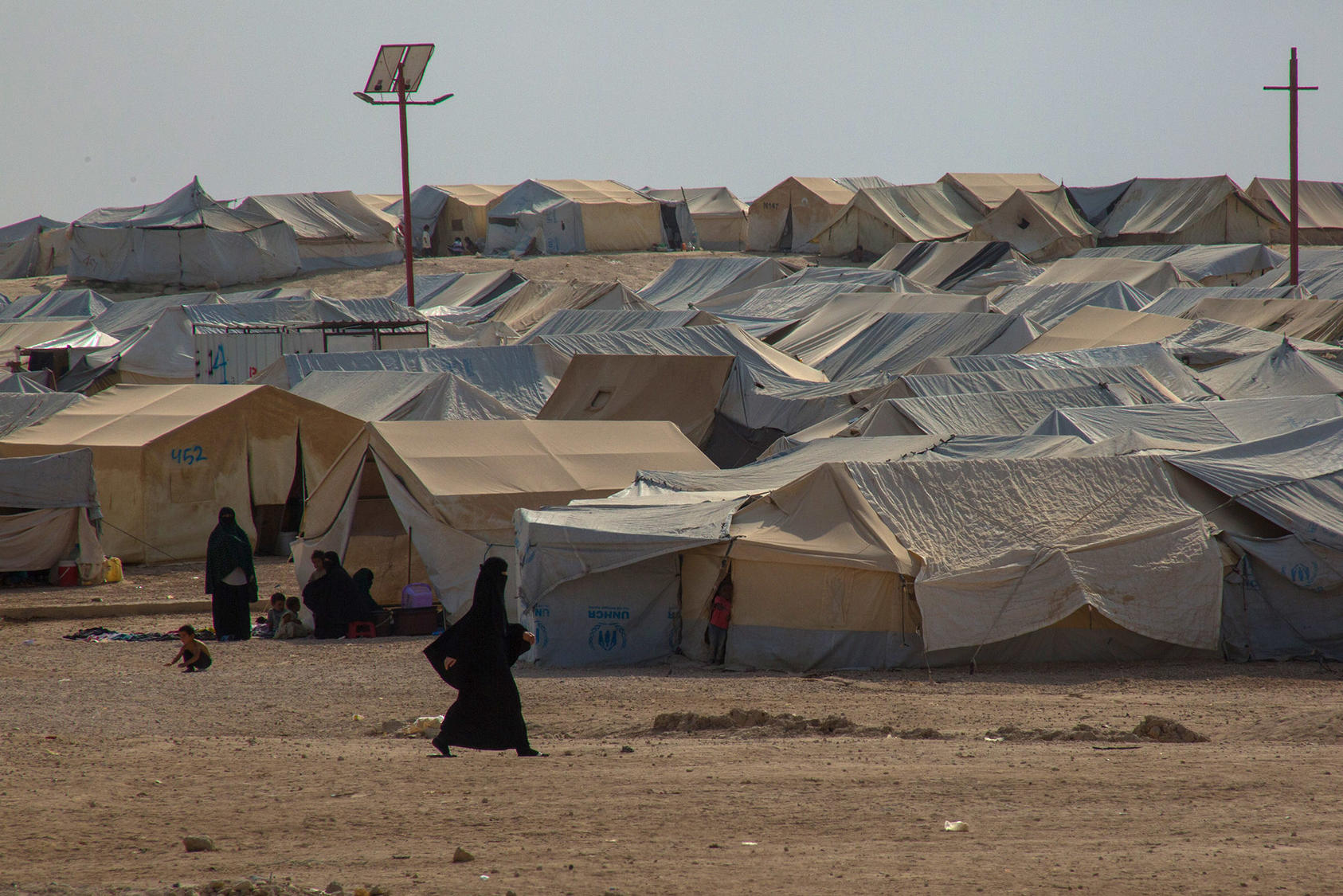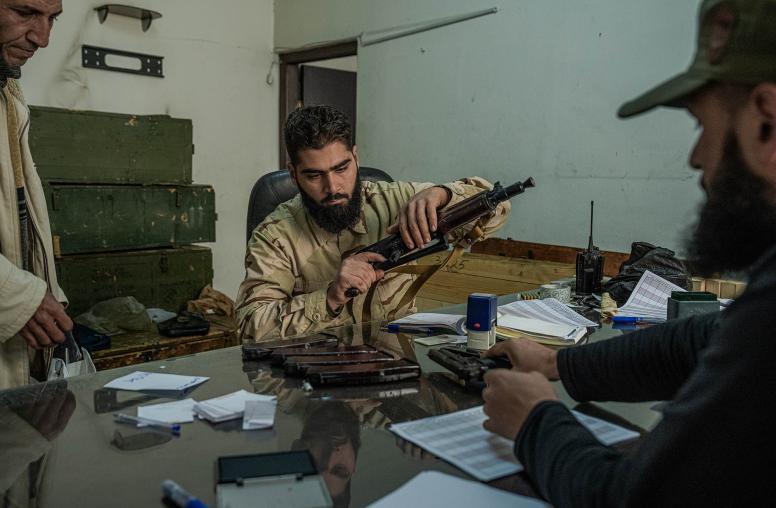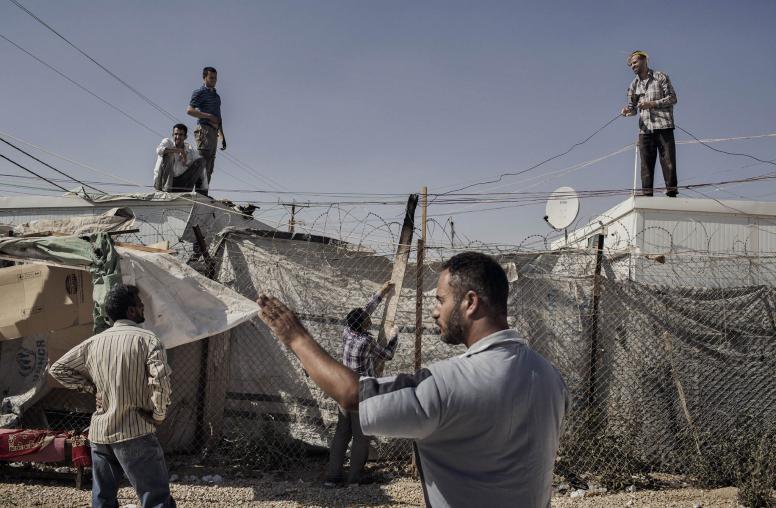Can Syrians Who Left ISIS Be Reintegrated into Their Communities?
Thousands of Syrian women and children set to be freed from al-Hol camp require support to ensure sustainable reconciliation.
More than a year since the territorial defeat of ISIS, the region is still reeling in the wake of the self-styled caliphate’s destruction. Kurdish authorities operate two dozen detention facilities in northeast Syria holding thousands of former ISIS fighters. What to do with these combatants remains a vexing challenge for the region and international community. But, the al-Hol camp in northeast Syria—which holds tens of thousands who were living among the terrorist organization—presents its own unique problems. Two-thirds of the camp’s residents are children; nearly all the rest are women. The camp’s population is comprised of 48 percent Iraqis and 37 percent Syrians with third-country nationals making up the rest. On October 5, Kurdish authorities in charge of al-Hol said they would free the 24,000 Syrians in the camp, where conditions have become increasingly unsustainable. USIP’s Mona Yacoubian, Chris Bosley, and Leanne Erdberg Steadman look at what led to the decision to release these Syrians and the challenges ahead for reintegrating them into their communities.

Why did the Syrian Democratic Council's decide to release 24,000 Syrian inhabitants of the al-Hol camp?
Yacoubian: The Kurdish-led Syrian Democratic Council (SDC) and its military counterpart the Syrian Democratic Forces (SDF) have long expressed concerns about their ability to manage the large populations that reside in numerous displacement camps under their control across northeast Syria. As the largest displacement camp, al-Hol, with an estimated 65,000 residents—primarily women and children (94 percent)—poses a particularly complex set of challenges, melding traditional protection concerns with mounting security issues. Over time, these challenges have become increasingly untenable.
Several factors likely prompted the October 5 announcement. First, Kurdish authorities have always viewed the camp’s Syrian residents differently from others (whether Iraqi or other foreign nationals), given their status as internally displaced; return within Syria is less complicated than to Iraq or other foreign countries.
Second, increasing strains inside al-Hol have highlighted the imperative to relieve pressure by lowering the number of camp inhabitants. Beginning in August, humanitarian actors reported a significant deterioration in security, noting 16 murders including 10 last month alone. They assert that several dynamics appear to drive these violent incidents (which have occurred primarily among the camp’s Iraqi population) including revenge crimes, tribal disputes, so-called “honor killings,” and charges of collaboration with camp security forces. The recent uptick in camp security incidents occurs against a backdrop of humanitarian funding gaps, a sharp economic decline across Syria, and the spread of the COVID-19 pandemic. Taken together, these forces have exacerbated pressures inside the camp and added to the strain of its administration.
Beyond the burdens directly associated with administering the al-Hol camp, the SDC has faced increasing pressure from local Arab tribal communities, particularly from Deir Zor governorate in eastern Syria, to release women and children from their communities. These demands come as tensions between Kurdish authorities and local Arab tribal communities have grown more acute, reflecting both long-standing Arab grievances over the Kurds’ heavy-handed approach to local governance as well as a more recent spate of assassinations of tribal leaders in the area. Signaling this priority, Kurdish authorities announced that the first group of 289 people, who were released on October 14, hailed from Deir Zor. These releases should help bolster tribal heads’ credibility with their populations while also improving Kurdish relations with the tribes.
Finally, Kurdish-dominant communities in other parts of northeast Syria harbor resentments of a different kind. They express anger at the resources spent in al-Hol to house and feed people whom they view as ISIS sympathizers. Given the significant needs across northeast Syria, Kurdish residents demand that more resources instead flow to their communities rather than being spent in al-Hol and other displacement camps. More broadly, these tensions underscore the deep fraying of Syria’s social fabric and the significant social cohesion work that lies ahead.
How will the releases take place? What are the main challenges facing receiving communities?
Yacoubian: The releases likely will continue to take place gradually via an established “sponsorship process” between Kurdish authorities and tribal heads, with local guarantors responsible for those released. Since 2019, more than 5,300 Syrians have been released from the camp through this process. The releases were paused temporarily due to the pandemic. U.S. officials have commented favorably that established security vetting procedures will remain in place. However, given the urgency of the Kurdish announcement, the releases could be accelerated. As noted above, the first tranche of releases will be to communities under SDF control across northeast Syria. Separate procedures for those Syrian inhabitants from areas currently under Syrian regime or Turkish control will need to be developed before those inhabitants can return.
While local communities have long demanded the release of their women and children from al-Hol, their capacity to absorb these returnees is questionable. An underdeveloped region prior to the Syrian conflict, Deir Zor governorate now must contend with the ravages of conflict amid spiraling impoverishment. Children comprise 17,000 of al-Hol’s Syrian population; many suffer from trauma and inadequate schooling. Yet, schools and “safe spaces” are sorely lacking in the region, nor are there sufficient psychosocial resources. For Syrian women returning, livelihood assistance will also be necessary. Barring a significant infusion of resources into these communities to address these shortfalls—in education, psychosocial, and livelihood support—releasing Syrians back to these communities will compound the difficult challenges they face and imperil the success of reintegration.
In what way are those Syrians set for release associated with ISIS? What challenges do they face and what kind of support is required to ensure they are disengaged from violent extremism?
Bosley: It’s important to remember that in Syria, there are few clear lines between victims, bystanders, sympathizers, adherents, and fighters. The returning children must be considered victims and treated by child-development specialists with their protection and wellbeing prioritized. But there are also several thousand women. Women played a variety of roles within ISIS, including perpetrating violence and enforcing ISIS’s brutal way of life; others were victims caught up in the chaos or forced to associate with ISIS. Most are victims in some ways and perpetrators in others, and disentangling and categorizing them will be impossible.
Regardless of how they associated with ISIS, we know how people disengage from violence and violent extremism. Violent extremism is often a fundamentally social challenge stemming from marginalization, isolation, and social exclusion. Sustained, positive, and inclusive interaction with others is associated with disengagement from all sorts of violent behaviors, including extremism. Peacebuilders know first-hand how social network diversity, cross-cutting social ties, and social inclusion can build relationships and empathy, transform identities, foster reconciliation, and generate a sense of belonging—the very things that provide resiliencies to violent extremism. So, lowering barriers—individual, communal, and structural—to these kinds of interactions is key.
Trauma is one of those barriers, and in almost every case trauma will present an enormous burden for a group of people who experienced brutality, violence (including sexual violence), and conflict in daily life under ISIS’s rule. Trauma is often associated with violent extremism as it amplifies perceptions of isolation and makes it difficult to build social bonds. The stress and perceptions of helplessness associated with reintegration can aggravate trauma, and everyone involved in reintegration—families, friends, educators, health providers, social workers, and law enforcement authorities—should know what to expect from people who have experienced severe trauma and how to avoid worsening that trauma. Where prosocial engagement with others is key, and a willingness to engage is essential, addressing traumas that can incite avoidance behavior can ease open those opportunities for transformation.
But sincere engagement is a two-way street; it involves a willingness to engage among returning persons as well as open spaces in communities where such engagement can occur. And communities may understandably feel betrayed and angry with people who engaged with ISIS. So, reducing stigma and fostering a sense of justice is crucial. Although amnesty doesn’t allow for criminal justice, restorative justice can repair social harms, rebuild relationships, and achieve reconciliation. Restorative justice mechanisms—such as redemption rituals and dialogues—can transform identities, foster acknowledgement of harm, promote redemption, and open space for the community to offer restored membership. Violent extremism targets entire communities, not only individuals, and respectful dialogue and community-based redemption rituals with deep roots in social ethos and community identity are uniquely positioned to engage entire communities in healing and provide a pathway for moving forward together.
What do affected communities need to prepare for the return of people from al-Hol? What can facilitate justice and reconciliation between returning persons and affected communities and ensure reintegration is peaceful and sustainable?
Erdberg Steadman: As Syrian communities contend with COVID, a deteriorating economy, power rivalries, and food insecurity, the return of those coming back from al-Hol are only one of a host of concurrent challenges. And in post-conflict environments, where few hands are clean and widespread trauma and destruction is pervasive, enabling a future not solely defined by the past requires focusing on people’s capacity for change and promoting well-being. It involves addressing the myriad ways that the social fabric is broken, but also what remains strong. And it entails finding pragmatic ways for communities to protect against real threats, while not exacerbating the reasons why people join ISIS or groups like it.
To do so, disengagement from violent extremism and fostering community reconciliation must be included in traditional stabilization activities. These used to include access to services, cleanup of destructed places, and facilitation of health and food assistance. But an augmented stabilization playbook should also include behavioral health and psychosocial support, providing child-friendly spaces and trauma-informed care, expanded emphasis on education and wellbeing, and support for local rituals that tackle the realities for reckoning, accountability, and reconciliation.
There is a very real likelihood that some local communities will never want to reconcile with former ISIS members; others will be angry if disengaged persons get special treatment when communities who never were violent are still suffering. But in this case, it is imperative to show communities how these efforts are not charity; they are instead a practical necessity to prevent further resurgence of violence.
Lastly, while surveillance and scrutiny are likely to occur (and in some cases, will be incredibly important to prevent further ISIS resurgence), communities must be mindful that security-centric activities do not weaken social cohesion or sow distrust, which would only impair overall efforts to build communities free from not just ISIS, but the next iteration of extremism.


